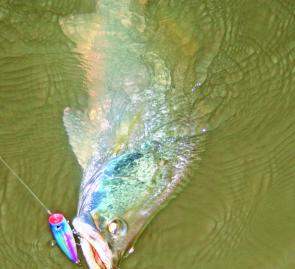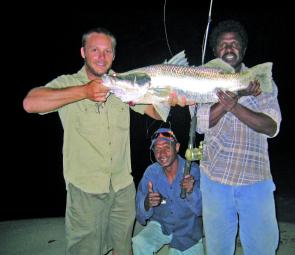April is an interesting time to be in Aurukun. The fishing this time of year will depend completely upon what kind of wet season the place has had and whether or not the wet is over.
However one factor remains a constant, the fishing in April can be superb. Around these parts barramundi are eating just about anything in their path.
Nutrient rich waters bring an endless source of food to hungry predators. It is a transition time and opportunistic species are making the most of having food delivered to them by the current. There may still be a considerable amount of fresh water in the systems and only certain species will be active.
The water may or may not have cleared up enough for what the locals call ‘white-fish’ to move into the rivers. Late rains can mean the queenfish and trevally set to infest the estuaries will still be off-shore somewhere.
Anglers fishing tropical rivers this time of year will be trying desperately to find a hot bite. Those anglers who find barramundi queuing up in certain places ready to inhale whatever swims past, can be in for a great time.
Quite often, the fishing will be better on a receding tide. Large volumes of water flowing downstream means anglers will need to find fish converging into strategic points within the river.
For many estuary fish, the desire to stay together in schools of near-equal size is overwhelming. Lucky for us, many tropical species will go into ballistic-feeding mode after they see one of their brethren disappearing with a prize in its mouth.
Barramundi are a classic example of fish that will gather together to sit in strategic points within an estuary. Find one and a follow up cast to the same spot is definitely in order.
Looking for where current lines mix two distinct bodies of water, casts across and adjacent to a colour change will be effective. Downstream facing points will have quieter water on one edge. A few casts into this backwater, using a very slow, twitching retrieve might turn them on.
Casts made upstream of large snag piles will get you strikes, but the fish will have an advantage in any ensuing battle. When a good barra is hooked and he runs down current into snags, do everything within reason to try and stop it. However never give up just because a barra has you in the timber.
Quite often they will get around that first stick and stay there, surging in the current. Patience is a virtue here and the most unlikely of captures can still be made 15mins after getting entangled in snags. This would never happen with a jack or even a little cod.
April is also the month many of the smaller feeder creeks and lilly-lined sections of upstream river are a pleasure to fish. Everything is green, new snags have fallen from their banks, conditions are mild and fish are finding their fins. Mangrove jack, small barra, saratoga and plenty of archer fish can be found well into the freshwater reaches, all willing to smash lures.
Casting small poppers around dusk up in these spots is magic. Seeing a popper launched into the air by a snapping jack or engulfed by the bow-wave of a barra. A golden flash followed by a round boil of water underneath means a saratoga came close. Archer fish will smack it a split second after touch down whereas a sooty grunter waits then chomps.
If you fish purely for the pleasure of fishing, or if you go fishing just to catch a feed, April is possibly the best month of the year all round. Swimming, fishing and crabbing are all great alternatives to one another.
Reads: 1803
Barra popped up in the south arm of the Archer River

This barra is a result of casting fizzers on dusk at the mouth of tiny creeks.




